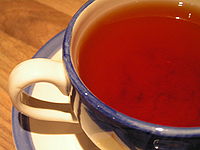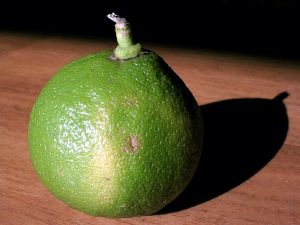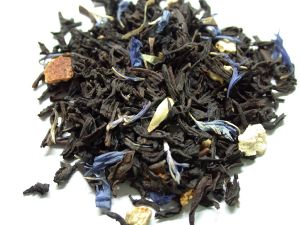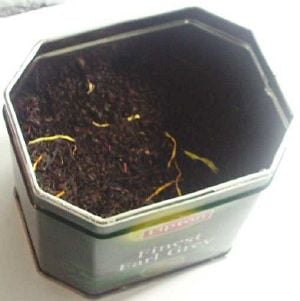Difference between revisions of "Earl Grey tea" - New World Encyclopedia
(→Use) |
(→Use) |
||
| Line 35: | Line 35: | ||
==Use== | ==Use== | ||
| − | In addition to being drunk as a hot beverage, Earl Grey tea is used as a flavoring for many types of [[cake]]s and [[confectionery]], such as [[chocolate]]s, as well as savory sauces.<ref name=Joachim2001>David Joachim, ''Brilliant Food Tips and Cooking Tricks: 5,000 Ingenious Kitchen Hints, Secrets, Shortcuts, and Solutions'' (Rodaleyear, 2001, ISBN 978-1579543013).</ref> For sauces, the flavor is normally created by adding tea bags to the basic stock, boiling for a few minutes and then discarding the bags. For sweet recipes, loose tea is often added to melted butter or hot cream and strained after the flavor is infused.<ref name=Boyle2002>Tish Boyle, ''The good cookie: over 250 delicious recipes from simple to sublime'' (John Wiley and Sons, 2002, ISBN 978-0471387916), 124. </ref> | + | In addition to being drunk as a hot beverage, Earl Grey tea is used as a flavoring for many types of [[cake]]s and [[confectionery]], such as [[chocolate]]s, as well as savory sauces.<ref name=Joachim2001>David Joachim, ''Brilliant Food Tips and Cooking Tricks: 5,000 Ingenious Kitchen Hints, Secrets, Shortcuts, and Solutions'' (Rodaleyear, 2001, ISBN 978-1579543013).</ref> For sauces, the flavor is normally created by adding tea bags to the basic stock, boiling for a few minutes and then discarding the bags. For sweet recipes, loose tea is often added to melted butter or hot cream and strained after the flavor is infused.<ref name=Boyle2002>Tish Boyle, ''The good cookie: over 250 delicious recipes from simple to sublime'' (John Wiley and Sons, 2002, ISBN 978-0471387916), 124. </ref><ref>Edward Schneider, [http://pqasb.pqarchiver.com/washingtonpost/access/99891436.html?FMT=ABS&FMTS=ABS:FT&date=Jan+16%2C+2002&author=Edward+Schneider&pub=The+Washington+Post&edition=&startpage=F.01&desc=Cooking+With+Tea%3B+%22As+for+pears%2C+I+poached+them+in+Earl+Grey%2C+a+tea+with+impeccable+prime+ministerial+credentials.%22 Cooking With Tea; "As for pears, I poached them in Earl Grey, a tea with impeccable prime ministerial credentials."] ''The Washington Post'', January 16, 2002. Retrieved February 12, 2013.</ref> |
==Potential health benefits== | ==Potential health benefits== | ||
Revision as of 22:11, 12 February 2013
Earl Grey tea is a tea blend with a distinctive flavor and aroma derived from the addition of oil extracted from the rind of the bergamot orange, a fragrant citrus fruit.
Traditionally, the term "Earl Grey" has applied only to black teas that contain oil of bergamot as a flavoring.
Preparation
History
Tea flavored with bergamot to imitate the more expensive types of Chinese tea is known in England at least since the 1820s. In 1837 there is a record of court proceedings against Brocksop & Co. who were found to have supplied tea "artificially scented, and, drugged with bergamot in this country", but there is no known published reference to an 'Earl Grey' tea before advertisements by Charlton & Co. of Jermyn Street in London in the 1880's, though 'Grey's Tea' is known from the 1850s. [1]
Both London tea merchants Twinings in The Strand and Jackson's of Piccadilly have claimed the product as their own.[1] Twinings obtained the endorsement of Richard, the sixth Earl Grey (born 1939), and his signature appears on their packages.
The Earl Grey blend, or 'Earl Grey's Mixture' is assumed to be named after the 2nd Earl Grey, British Prime Minister in the 1830's and author of the Reform Bill of 1832, who reputedly received a gift, probably a diplomatic perquisite, of tea flavored with bergamot oil.[2] Bergamot orange (Citrus bergamia) is a small citrus tree which blossoms during the winter and is grown commercially in Calabria, Italy.[3] It is likely a hybrid of Citrus limetta and Citrus aurantium.[4]
According to one legend, a grateful Chinese mandarin whose son was rescued from drowning by one of Lord Grey's men first presented the blend to the Earl in 1803. The tale appears to be apocryphal, as Lord Grey never set foot in China[5] and the use of bergamot oil to scent tea was then unknown in China. However, this tale is subsequently told (and slightly corrected) as on the Twinings website, as "having been presented by an envoy on his return from China".[6]
Jacksons of Piccadilly claim they originated Earl Grey's Tea, Lord Grey having given the recipe to Robert Jackson & Co. partner George Charlton in 1830. According to Jacksons, the original recipe has been in constant production and has never left their hands. Theirs has been based on China tea since the beginning.[7][8]
According to the Grey family, the tea was specially blended by a Chinese mandarin for Lord Grey, to suit the water at Howick Hall, the family seat in Northumberland, using bergamot in particular to offset the preponderance of lime in the local water. Lady Grey used it to entertain in London as a political hostess, and it proved so popular that she was asked if it could be sold to others, which is how Twinings came to market it as a brand.[9]
Variations
There are dozens of variants of Earl Grey tea, including lavender, green, and floral.
A particularly popular variant is known as Lady Grey, named after Mary Elizabeth Grey, the wife of Charles Grey, 2nd Earl Grey, for whom Earl Grey tea is named. It contains lemon and Seville orange in addition to bergamot, producing a more subtle flavor. The Twinings blend contains black teas, Seville orange, lemon, bergamot, and cornflower. Other variations may include lavender instead of or in addition to the Seville oranges.
- Other variations of Earl Grey tea may include such ingredients as jasmine, as well as other flowers.
- A blend with added rose petals is known as French Earl Grey.
- A variety called Russian Earl Grey often contains ingredients such as citrus peels and lemon grass in addition to the usual black tea and bergamot.
- There are different varieties of Lady Grey tea; the two most common kinds (Lavender Lady Grey and Citrus Lady Grey), which combine Earl Grey tea with lavender and Seville oranges, respectively.
- Several companies make a tea called Earl Grey Green, combining green tea leaves rather than the traditional black tea leaves with bergamot flavoring.
- Rooibos Earl Grey is a variation using this South African tisane as a substitute for the conventional form made with black tea. It is a caffeine-free alternative for Earl Grey lovers.
Use
In addition to being drunk as a hot beverage, Earl Grey tea is used as a flavoring for many types of cakes and confectionery, such as chocolates, as well as savory sauces.[10] For sauces, the flavor is normally created by adding tea bags to the basic stock, boiling for a few minutes and then discarding the bags. For sweet recipes, loose tea is often added to melted butter or hot cream and strained after the flavor is infused.[11][12]
Potential health benefits
Bergamot oil can be a health supplement when used properly.
Potential adverse effects
In several studies, application of high concentrations of some brands of bergamot oil directly to the skin was shown to increase redness after exposure to ultraviolet light;[13][14] however, this should not apply to ordinary oral consumption of Earl Grey tea. Bergamot is a source of bergamottin which, along with the chemically related compound 6’,7’-dihydroxybergamottin, is known to be responsible for the grapefruit juice effect in which the consumption of the juice affects the metabolism of a variety of pharmaceutical drugs.[15]
In one case study, a patient who consumed four litres of Earl Grey tea per day reported muscle cramps, which were attributed to the function of the bergapten in bergamot oil as a potassium channel blocker. The symptoms subsided upon reducing his consumption of Earl Grey tea to one litre per day.[16]
In popular culture
Earl Grey tea appears frequently in popular culture. It is the favorite drink of a variety of fictional characters, including Jean-Luc Picard of the television series Star Trek: The Next Generation, Artemis Fowl, Piglet from Winnie-the-Pooh byA. A. Milne, and Sir Leigh Teabing from the The Da Vinci Code by Dan Brown, among many others.
Notes
- ↑ 1.0 1.1 Earl Grey tea The Foods of England. Retrieved February 12, 2013.
- ↑ Kramer, Ione. All the Tea in China. China Books, 1990. ISBN 0-8351-2194-1. Pages 180-181.
- ↑ Ben Richardson, Bergamot growers get whiff of success BBC News, April 6, 2006. Retrieved February 12, 2013.
- ↑ RFLP Analysis of the Origin of Citrus Bergamia, Citrus Jambhiri, and Citrus Limonia. International Society for Horticultural Science. Retrieved 18 February 2012.
- ↑ Pettigrew, Jane (2004). The Tea Companion: A Connoisseur's Guide (Connoisseur's Guides). Philadelphia, Pa: Running Press Book Publishers. ISBN 0-7624-2150-9.
- ↑ Earl Grey. Twiningsusashop.com. Retrieved 2010-12-07.
- ↑ Fenix, Micky, "More Than Just A Pot Of Tea", Philippine Daily Inquirer, 24 July 2008.
- ↑ Pagano, Margareta, "The secret of Earl Grey tea is changing hands at last / Sale of Jacksons of Piccadilly to Fitch Lovell food manufacturing group", The Guardian (London), 3 July 1985.
- ↑ Howick Hall website. Howickhallgardens.org. Retrieved 2011-01-28.
- ↑ David Joachim, Brilliant Food Tips and Cooking Tricks: 5,000 Ingenious Kitchen Hints, Secrets, Shortcuts, and Solutions (Rodaleyear, 2001, ISBN 978-1579543013).
- ↑ Tish Boyle, The good cookie: over 250 delicious recipes from simple to sublime (John Wiley and Sons, 2002, ISBN 978-0471387916), 124.
- ↑ Edward Schneider, Cooking With Tea; "As for pears, I poached them in Earl Grey, a tea with impeccable prime ministerial credentials." The Washington Post, January 16, 2002. Retrieved February 12, 2013.
- ↑ Girard J, Unkovic J, Delahayes J, Lafille C (1979). Phototoxicity of Bergamot oil. Comparison between humans and guinea pigs. Dermatologica 158 (4): 229–43.
- ↑ Kejlova K, Jirova D, Bendova H, Kandarova H, Weidenhoffer Z, Kolarova H, Liebsch M (2007). Phototoxicity of bergamot oil assessed by in vitro techniques in combination with human patch tests. Toxicology in Vitro 21 (7): 1298–1303.
- ↑ David G. Bailey, J. Malcolm, O. Arnold, J. David Spence (1998). Grapefruit juice–drug interactions. Br J Clin Pharmacol 46 (2): 101–110.
- ↑ Finsterer J (2002). Earl Grey tea intoxication. Lancet 359 (9316).
ReferencesISBN links support NWE through referral fees
- Chow, Kit, and Ione Kramer. All the Tea in China. San Francisco, CA: China Books, 1990. ISBN 0835121941
- Harney, Michael. The Harney & Sons Guide to Tea. New York, NY: The Penguin Press, 2008. ISBN 978-1594201387
- Heiss, Mary Lou, and Robert J. Heiss. The Story of Tea: A Cultural History and Drinking Guide. Berkeley, CA: Ten Speed Press, 2007. ISBN 978-1580087452
- Pettigrew, Jane. The Tea Companion: A Connoisseur's Guide. Philadelphia, PA: Running Press Book Publishers, 2004. ISBN 0762421509
- Pettigrew, Jane, and Bruce Richardson. The New Tea Companion: A Guide to Teas throughout the World. Perryville, KY: Benjamin Press, 2008. ISBN 978-0979343179
External links
All links retrieved February 5, 2013.
- Tending Toward Tea – an Earl Grey tea review site.
- Earl Grey descendants sell English tea to China Reuters.
- My Name Is Earl (Grey) Official Blog of the English Tea Store.
| ||||
| Black tea | Blended and flavored teas | Chinese tea | Earl Grey tea | Green tea | Herbal tea | Lapsang souchong | Masala chai | Mate tea | Mint tea | Oolong tea | Turkish tea | White tea | Yellow tea | ||||
| Tea culture | Related to tea | |||
| China | India | Japan | Korea | Morocco | Russia | United Kingdom | United States | Samovar | Tea house | Teapot | Tea set | |||
Credits
New World Encyclopedia writers and editors rewrote and completed the Wikipedia article in accordance with New World Encyclopedia standards. This article abides by terms of the Creative Commons CC-by-sa 3.0 License (CC-by-sa), which may be used and disseminated with proper attribution. Credit is due under the terms of this license that can reference both the New World Encyclopedia contributors and the selfless volunteer contributors of the Wikimedia Foundation. To cite this article click here for a list of acceptable citing formats.The history of earlier contributions by wikipedians is accessible to researchers here:
The history of this article since it was imported to New World Encyclopedia:
Note: Some restrictions may apply to use of individual images which are separately licensed.




